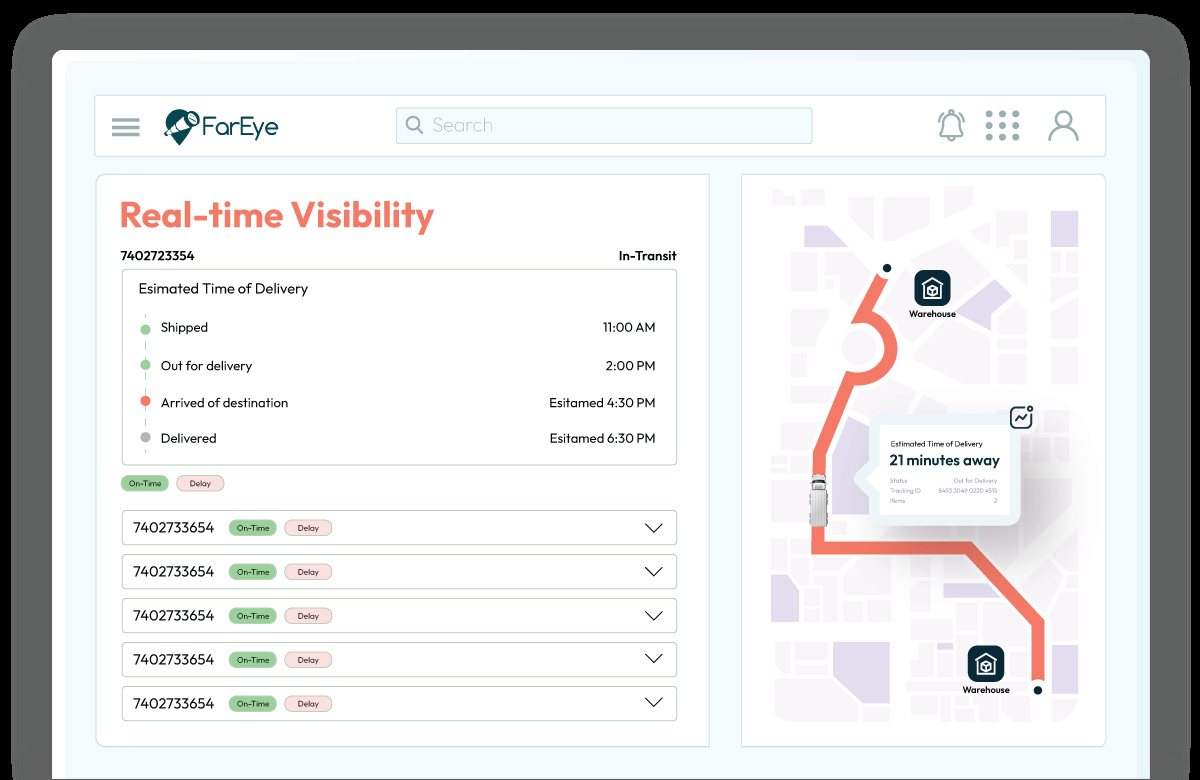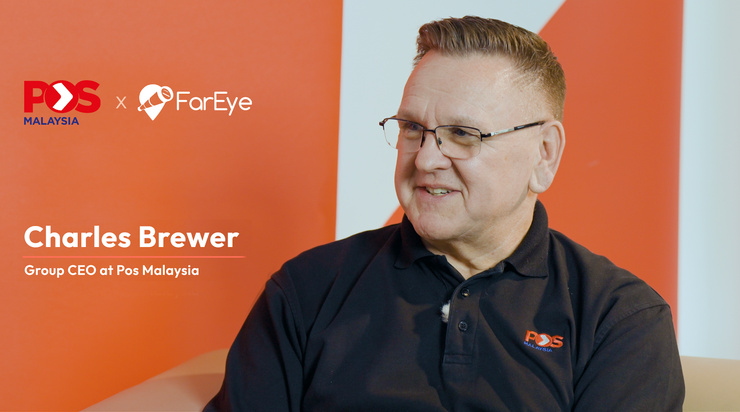- Logistics Complexity
- Ship
Ensuring Delivery Accuracy with Advanced Route Delivery Planning
Table of Contents
- Why Is Delivery Accuracy Critical in Modern Supply Chains?
- The Complexity of Modern Delivery Operations
- Core Principles of Route Delivery Planning
- Top Challenges in Achieving Delivery Accuracy
- Advanced Technology: The Game-Changer for Route Delivery Planning
- FarEye: The Ultimate Delivery Route Planner
- Weaving It All Together: A Roadmap to Delivery Excellence
- Converting Complexity into Competitive Advantage

Two years ago, a leading electronics retailer promised a “100% on-time delivery guarantee” during its holiday season sale. But as the orders piled up, its outdated manual processes for planning routes crumbled under pressure. Delivery vehicles got stuck in endless traffic, orders were wrongly assigned, and irate customers voiced their frustration across social media.
According to a report, 74% of consumers switch brands if delivery is consistently delayed or mishandled. The retailer learned the hard way, that with rising customer expectations, even a minor delay can cost both revenue and reputation.

This scenario echoes a persistent reality in today’s logistics ecosystem. Delivery accuracy isn’t just an operational metric; it’s a promise that can make or break brand loyalty. Ensuring that promise now hinges on advanced route delivery planning, a technology-driven approach designed to tame logistical chaos and optimize every mile traveled.
Why Is Delivery Accuracy Critical in Modern Supply Chains?
In a hyper-competitive world where instant gratification rules, delivery times are shrinking, and tolerance for error is vanishing. Online shoppers now expect same-day or even same-hour shipments.
Meanwhile, business buyers demand precise bulk deliveries that meet strict timelines. When deliveries arrive late or go astray, customers might churn—and take their discontent online.
- Impact on Profitability: Beyond lost business, poor delivery accuracy leads to elevated costs: fuel wastage, overtime pay, and rerouting resources.
- Brand Reputation: A single social post about a botched delivery can overshadow months of marketing efforts.
- Compliance Requirements: Some industries—like pharmaceuticals or food—have strict guidelines for timely, temperature-controlled shipments, leaving no room for errors.
With such heightened stakes, it’s clear that accurate route planning for delivery is more than a nice-to-have—it’s a strategic imperative.
The Complexity of Modern Delivery Operations
To truly appreciate why route delivery planning has become vital, consider the complexities supply chain managers juggle daily:
- Last-Mile Pressures
The last mile can constitute up to 53% of total shipping costs. - Multiple Constraints
Time Windows: Many customers require specific delivery slots (e.g., 9–11 AM).
Vehicle Capacity: Fluctuating package sizes, refrigeration requirements, and maximum load weight complicate planning.
Driver Scheduling: Regulatory caps on driver hours, breaks, and skill sets all play a role. - High Delivery Volumes
E-commerce booms, seasonal peaks, and enterprise-level distributions can overwhelm manual route planning methods. - Dynamic Disruptions
Traffic congestion, road closures, last-minute address changes, or urgent new orders can topple carefully planned schedules if they’re not dynamically updated. - Sustainability Goals
Growing pressure to minimize carbon emissions is steering supply chains to optimize miles traveled and integrate electric vehicles, adding yet another layer of complexity.
Clearly, manually plotting routes on spreadsheets or simply using a free mapping tool fails to address these layered demands. Instead, sophisticated technology and AI-driven capabilities are critical to planning a delivery route efficiently, accommodating real-time changes, and maintaining high accuracy.
Core Principles of Route Delivery Planning
At its heart, route delivery planning is about aligning resources—vehicles, drivers, cargo—with delivery requirements (addresses, time windows, constraints) in the most efficient and timely manner possible. Several pillars support this process:
- Data-Driven Approach
Accurate addresses, real-time traffic data, driver schedules, and order priorities form the backbone of route optimization. Machine learning models can predict congestion patterns or typical time on-site to fine-tune arrival estimates. - Dynamic Routing
An advanced delivery route planner updates routes mid-day if there’s a road accident or a truck breakdown, ensuring minimal disruptions to the overall plan. - Constraint Handling
Modern systems don’t just calculate mileage; they consider constraints like vehicle capacity, hazardous material regulations, or service-level agreements (SLAs). - Customer-Centric Focus
A robust route planning for delivery includes real-time tracking, transparent ETAs, and swift communication channels. This can boost customer satisfaction significantly. - Scalable Architecture
High-volume businesses require route optimization tools that can rapidly handle thousands of shipments across vast territories—often updated in real time.
By integrating these principles, supply chains can deliver on time with minimal costs, all while preserving driver well-being and meeting compliance norms.
Top Challenges in Achieving Delivery Accuracy
Even with an understanding of key principles, many businesses stumble over persistent challenges:
- High Operational Costs
Fuel prices fluctuate; idle times grow due to suboptimal routes. Over time, these small inefficiencies balloon into significant overhead. - Ineffective Capacity Utilization
A half-empty vehicle or a mismatch between truck size and parcel volume can inflate per-delivery costs. - Unreliable Address Data
Incomplete or incorrect addresses can send drivers on wild goose chases, causing delays and missed time windows. - Empty Backhauls
Vehicles often return empty after deliveries. Without an integrated plan for return trips, businesses waste opportunities for cost recovery or additional pickups. - Driver Shortage and Turnover
Burnout rates spike when drivers face stress from unrealistic deadlines or poorly planned routes. This turnover further strains operational efficiency.
Solving these pain points requires more than incremental changes; it calls for a holistic, technology-driven reinvention of how businesses plan delivery routes.
Advanced Technology: The Game-Changer for Route Delivery Planning
- AI-Driven Route Optimization
Modern route delivery planning thrives on predictive analytics and AI. By feeding historical data (driver performance, regional traffic patterns), the system refines each new plan, inching closer to perfect accuracy over time. - Real-Time Dynamic Adjustments
Traffic jams, canceled deliveries, or emergent customer requests become manageable when the system can automatically reassign tasks or reorder stops—ensuring minimal friction. - Integrated Fleet Management
From tracking vehicle performance to monitoring driver hours, advanced solutions unify data streams into a single dashboard. This synergy prevents siloed information, enabling quick, informed decisions. - Sustainability Analytics
Many route planning solutions now factor in carbon footprint goals, optimizing routes to reduce fuel consumption and presenting “green windows” for eco-friendly deliveries.
FarEye: The Ultimate Delivery Route Planner
When discussing advanced route planning, FarEye stands out as a comprehensive, AI-powered platform that addresses the full spectrum of logistics challenges. It doesn’t just plan delivery routes; it transforms the entire delivery lifecycle—empowering businesses to meet customer demands, reduce expenses, and gain real-time visibility.
- AI-Powered Insights & Precise Geocoding
FarEye harnesses cutting-edge AI to analyze order clusters, historical traffic, and driver performance, tailoring routes that drastically reduce wasted miles.
Its geocoding engine eliminates address inefficiencies, avoiding scenarios where drivers circle blocks searching for obscure locations. - Dynamic, Constraints-Based Scheduling
Delivery constraints can be as varied as temperature needs for perishable goods, last-mile restricted zones, or scheduled driver breaks. FarEye’s route delivery planner seamlessly factors these constraints into optimized routes.
Vehicles, capacity, driver certifications, and even shift timings are centrally accounted for—ensuring the plan is realistic and compliance-friendly. - Customized Routing for Varied Logistics Models
LTL/FTL Routing: Plan complex multi-day routes with driver working hours (DoT compliance) built in. Optimize load planning for co-mingled shipments and reduce empty backhauls.
Parcel Routing: For same-day or next-day deliveries, FarEye organizes stops to balance speed, reduce driver fatigue, and keep last-mile drop-offs running smoothly. Features like loop optimization and EV routing open new sustainability opportunities.
Hyperlocal Dispatch: On-demand delivery? FarEye’s broadcasting and dynamic allocation capabilities ensure immediate assignment to nearby drivers, cutting down response times.
Scheduled Routing: Offer time-slot deliveries with real-time visibility into existing orders, capacity, and driver rosters to enhance first-attempt success rates.
Territory Planning: FarEye analyzes historical data to carve out optimal service areas, balancing workloads and saving fuel in the process. - Real-Time Visibility & Dynamic Rerouting
With real-time tracking, dispatchers can instantly address disruptions—rerouting a vehicle due to unforeseen congestion or diverting a nearby driver to fulfill a high-priority request.
Proactive communication tools ensure both drivers and customers stay informed about any potential delays or route changes. - Sustainability Focus
FarEye supports green delivery initiatives by suggesting eco-friendly routes and maximizing load factors. This leads to fewer miles driven, less fuel used, and lower emissions—aligning with global sustainability mandates. - Plug & Play Routing API
Integration is often a barrier when deploying new technology. FarEye’s ready-to-use API easily connects with existing Order Management Systems (OMS) or Transport Management Systems (TMS). You can instantly request optimized routes and fetch results in real-time, drastically simplifying tech adoption. - Outcome-Driven Efficiency
Reduced Operational Costs: By eliminating inefficiencies, businesses often see immediate cost relief, from lower fuel bills to reduced overtime expenses.
Higher Delivery Accuracy: With advanced route planning for delivery, misdeliveries drop, and on-time rates soar—bolstering both revenue and reputation.
Boosted Customer Satisfaction: Timely ETAs, transparent tracking links, and smooth deliveries create memorable customer experiences, driving loyalty.
Weaving It All Together: A Roadmap to Delivery Excellence
From small courier operations to multinational retail conglomerates, the relentless pressure for on-time, accurate deliveries is universal. The stakes—brand loyalty, revenue, and operational stability—are too critical to ignore. Here’s how organizations can chart a path to success:
- Assess Current Bottlenecks
Map out where most delays or errors occur. Is it inefficient order batching, incorrect addresses, or limited driver visibility? - Gather Clean Data
Ensure addresses, driver schedules, and capacity details are accurate and up-to-date. The best route delivery planning depends on reliable input. - Invest in an Advanced Solution
Manual approaches and basic mapping tools won’t cut it. Leverage an AI-powered platform like FarEye to dynamically manage constraints, incorporate real-time events, and scale as your volume grows. - Train Your Team
A sophisticated delivery route planner only shines when dispatchers, drivers, and managers fully understand its capabilities. Provide regular training and encourage feedback loops. - Continually Monitor & Refine
Track KPIs such as on-time delivery percentage, cost per delivery, and driver productivity. Use these metrics to refine processes, test new tactics, and meet evolving customer demands.
Converting Complexity into Competitive Advantage
Amid stiff competition and skyrocketing customer expectations, ensuring delivery accuracy isn’t optional—it’s the new norm. Whether coordinating thousands of parcels across a sprawling metropolis or scheduling long-haul freight runs across state lines, the challenges are immense and ever-changing. Yet, with an advanced route planning approach—backed by technology that handles dynamic constraints, real-time insights, and AI-driven optimization—businesses can transform these challenges into an edge.
That’s precisely where FarEye excels. Offering everything from precise geocoding to hyperlocal route dispatch, FarEye stands as a single, scalable platform built to meet modern demands. By weaving together state-of-the-art route technology, integrated workflows, and a deep commitment to customer satisfaction, it enables organizations to fulfill their promise of accurate, on-time deliveries—consistently, efficiently, and sustainably.
Reference:

Komal Puri is a seasoned professional in the logistics and supply chain industry. As the AVP of Marketing and a subject matter expert at FarEye, she has been instrumental in shaping the industry narrative for the past decade. Her expertise and insights have earned her numerous awards and recognition. Komal’s writings reflect her deep understanding of the industry, offering valuable insights and thought leadership.
Let's Talk to Our Experts and Optimize Your Deliveries Today!
An expert from our team will reach out within 24 hours
Related resources


